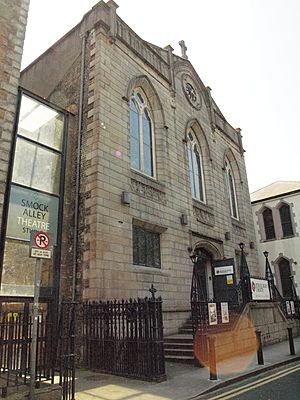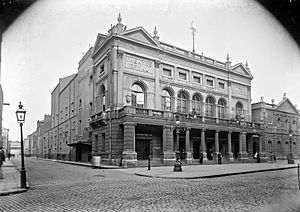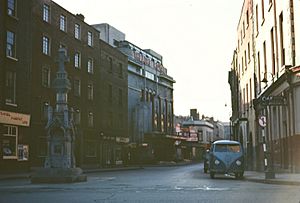Theatre Royal, Dublin facts for kids
Over many years, five different theatres in Dublin have been known as the Theatre Royal. In the past, the name "Theatre Royal" or "Royal Theatre" meant that the theatre had a special permission from the king or queen. This permission, called a royal patent, was needed to perform serious plays. Without it, certain types of theatre were not allowed by law. Many theatres with this special permission had other names too.
Contents
The First Theatre Royal (1662–1787): Smock Alley
The first Theatre Royal opened in 1662 in a place called Smock Alley. It was started by John Ogilby. He was the first "Master of the Revels" in Ireland. This job meant he was in charge of all entertainment for the king. Before this, Ogilby ran the New Theatre in Werburgh Street. That theatre was the first one built just for plays in Dublin. It opened in 1637 but closed in 1641 because of a group called the Puritans.
When the king returned to power in Ireland in 1661, Ogilby could go back to his job. He then opened his new theatre in Smock Alley. This Theatre Royal was mostly controlled by the government at Dublin Castle. It mainly showed plays that supported the royal family and classic plays by William Shakespeare.
In 1662, a writer named Katherine Philips came to Dublin. She finished translating a French play called Pompée. This play was a big success at the Smock Alley Theatre in 1663. It was special because it was the first rhymed French tragedy translated into English. It was also the first English play written by a woman to be performed professionally.
Later, in the 1700s, the famous actor-manager Thomas Sheridan ran the theatre. He was the father of the well-known writer Richard Brinsley Sheridan. Thomas Sheridan brought big stars from the London stage to Dublin. These included David Garrick and Dublin-born Peg Woffington. Charlotte Melmoth, who later became a famous tragic actress in America, started her career here. The theatre was pulled down and rebuilt in 1735. It closed in 1787 and was left empty for almost 30 years. It was even used as a warehouse.
In 1811, part of the old theatre was taken down. What was left became part of the new Church of St. Michael and St. Johns. This church was very popular until 1989. In 2012, after six years of work, the old church building became a theatre again. This new theatre is now home to the Gaiety School of Acting, which is Ireland's National Theatre School.
The Second Theatre Royal (1788–1818): Crow Street
The Crow Street Theatre first opened in 1758. In 1782, an actor named Richard Daly bought it. He got a special royal permission in 1786. Then, in 1788, he opened the theatre as the Theatre Royal. He spent a lot of money, about £12,000, to rebuild and decorate it. It made money for a while. But then, another theatre called Astley's Amphitheatre opened, which made things harder.
Frederick Edward Jones rented the theatre from Daly. He spent £1200 to make the theatre look new and beautiful. It opened in 1796 but had to close when martial law was declared. This was because of the Irish Rebellion of 1798. Jones got a new royal permission in 1798 and spent even more money, £5000, on the theatre. But because of the political situation, it closed again in 1803.
In 1814, the theatre was damaged in a riot. There were more riots in 1819. Jones thought people didn't like him because he was involved in politics. In 1818, he asked for his special permission to be renewed, but it was refused. Instead, it was given to Henry Harris, who owned the Covent Garden Theatre.
The Third Theatre Royal (1821–1880): Hawkins Street
In 1820, Henry Harris bought land in Hawkins Street. He built a new theatre there called the Albany New Theatre. It cost £50,000 and could seat 2,000 people. It opened in January 1821. In August, King George IV went to a show there. Because of his visit, the theatre got a royal patent. Its name was then changed to the "Theatre Royal."
The building was not fully finished when it opened. Not many people came at first, so some seating areas were closed off. On December 14, 1822, a famous event called the "Bottle Riot" happened. This was during a play called She Stoops to Conquer. The Lord Lieutenant, Marquess Wellesley, was there. Some people, called Orangemen, were angry with him for being kind to Catholics. They booed him during the national anthem. A riot started after something was thrown at him.
In 1830, Harris left the theatre, and a Mr. Calcraft took over. This theatre attracted many famous performers. These included Paganini, Jenny Lind, Tyrone Power, and Barry Sullivan. By 1851, the theatre had money problems and closed for a short time. It reopened in December under John Harris. He had managed the rival Queen's Theatre.
The first play under John Harris was by Dion Boucicault. Boucicault and his wife performed in his play The Colleen Bawn at the Royal in 1861. Another of Boucicault's plays, Arrah-na-Pogue, was first performed here in 1864.
This theatre was also known for its music. It had an orchestra that played music before and during plays and operas. The orchestra was led by Richard Michael Levey from 1834 until the theatre burned down on February 9, 1880. In March 1874, John and Michael Gunn took over the Theatre Royal from John Harris. John and Michael Gunn also owned the Gaiety Theatre. John managed the Gaiety, while Michael managed the Theatre Royal.
The Fourth Theatre Royal (1897–1934): Hawkins Street
The fourth Theatre Royal opened on December 13, 1897. It was opened by actor-manager Frederick Mouillot and some Dublin business people. The theatre was designed by Frank Matcham. It was built where the Leinster Hall theatre used to be, which was on the site of the third Theatre Royal. It could seat 2,011 people.
This new theatre had to compete with the Gaiety Theatre. So, Mouillot tried to bring in as many big stars and theatre groups as possible. At first, the theatre was famous for its opera and musical comedy shows. On April 28, 1904, King Edward VII attended a special performance there.
Mouillot passed away in 1911. One of his partners, David Tellford, took over. As musical comedy became less popular in the early 1900s, the Royal started showing music hall acts regularly. In one show in 1906, a young Charlie Chaplin performed as part of a group called The Eight Lancashire Lads. In its last years, the theatre was also used as a cinema. It closed on March 3, 1934, and was soon torn down.
The Fifth Theatre Royal (1935–1962): Hawkins Street
The fifth Theatre Royal opened on September 23, 1935, also on Hawkins Street. It was a big art deco building. It was designed for 3,700 seated people and 300 standing. It was meant to be used for both theatre and cinema. It also had the Regal Rooms Restaurant, which became the Regal Rooms Cinema in 1938. The theatre had its own 25-piece orchestra and a group of singer-dancers called the Royalettes.
From the start, the theatre's huge size made it hard to make enough money. To solve this, they first tried to book famous stars from other countries. These included Gracie Fields, George Formby, Max Wall, Max Miller, and Jimmy Durante. However, these shows rarely made a profit.
In 1936, Patrick Wall and Louis Elliman bought the Royal. They also owned the Gaiety. When the Second World War started, Wall and Elliman had to keep both theatres going with only Irish performers. This led to many Irish acts becoming famous. They became the main shows at the Royal for the rest of its time. These included well-known Irish names like Jimmy O'Dea, Harry O'Donovan, Maureen Potter, and Noel Purcell.
In July 1951, Judy Garland performed a series of sold-out shows. She received huge cheers. She even sang from her dressing room window to hundreds of people who couldn't get tickets. Critics called her "America's Colleen." She brought the biggest crowds until that time. Only visits by United States President John F. Kennedy in 1963 and Pope John Paul II in 1979 brought more people. Popular Irish American entertainer Carmel Quinn also started her singing career here in the early 1950s.
The fifth Theatre Royal closed its doors on June 30, 1962. This was due to rising costs and the growing popularity of cinema and television. However, some people who criticized the developers who bought the theatre believed there were other reasons for its closure. The building was later torn down. A twelve-story office block, Hawkins House, was built in its place. This was the main office for Ireland's Department of Health until 2019.
In 1972, The New Metropole opened nearby. It operated as the Screen Cinema from 1984 until 2016. That building was also torn down in 2019.
Legacy
In 2022, during new building work in the area, a campaign began. People wanted to rename a street near where the theatre used to be as Theatre Royal Way.





